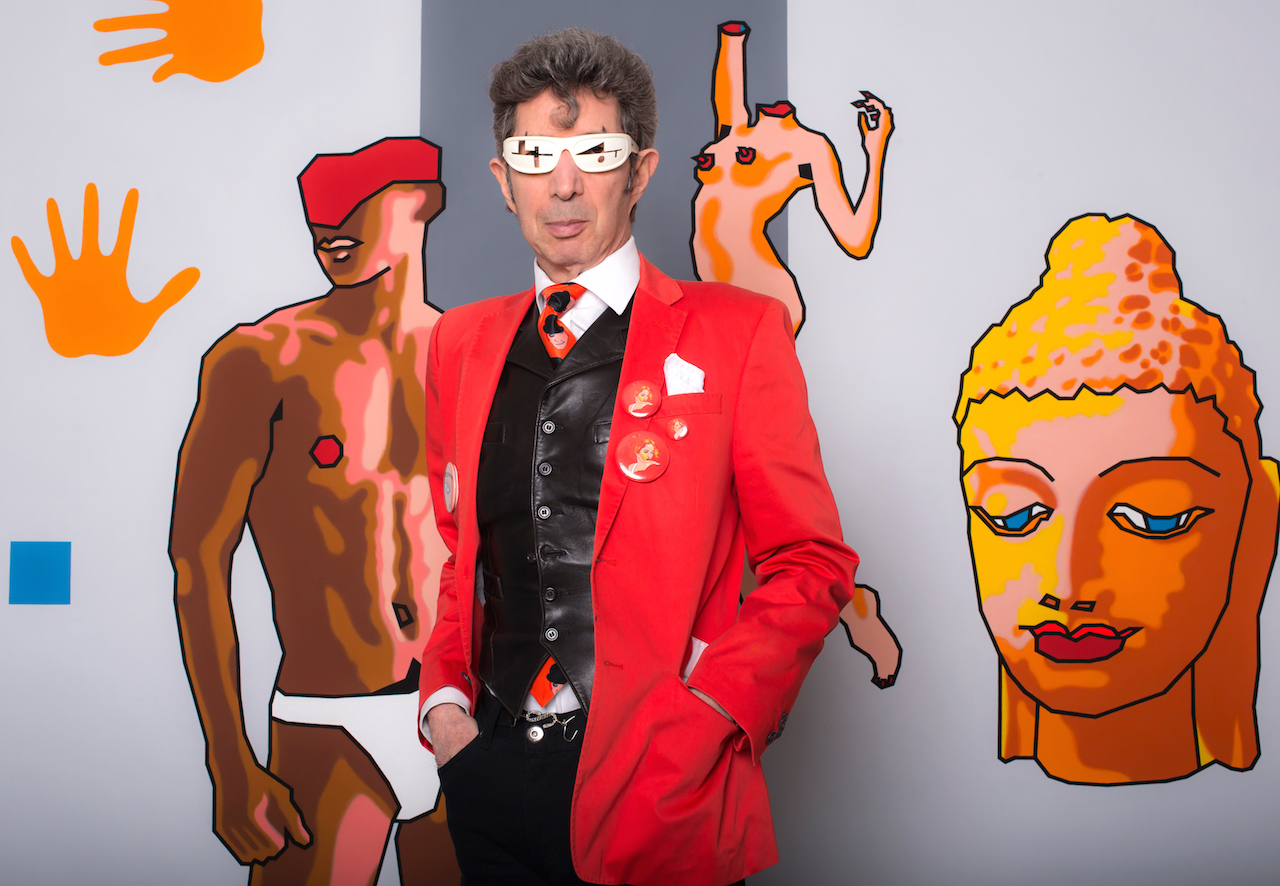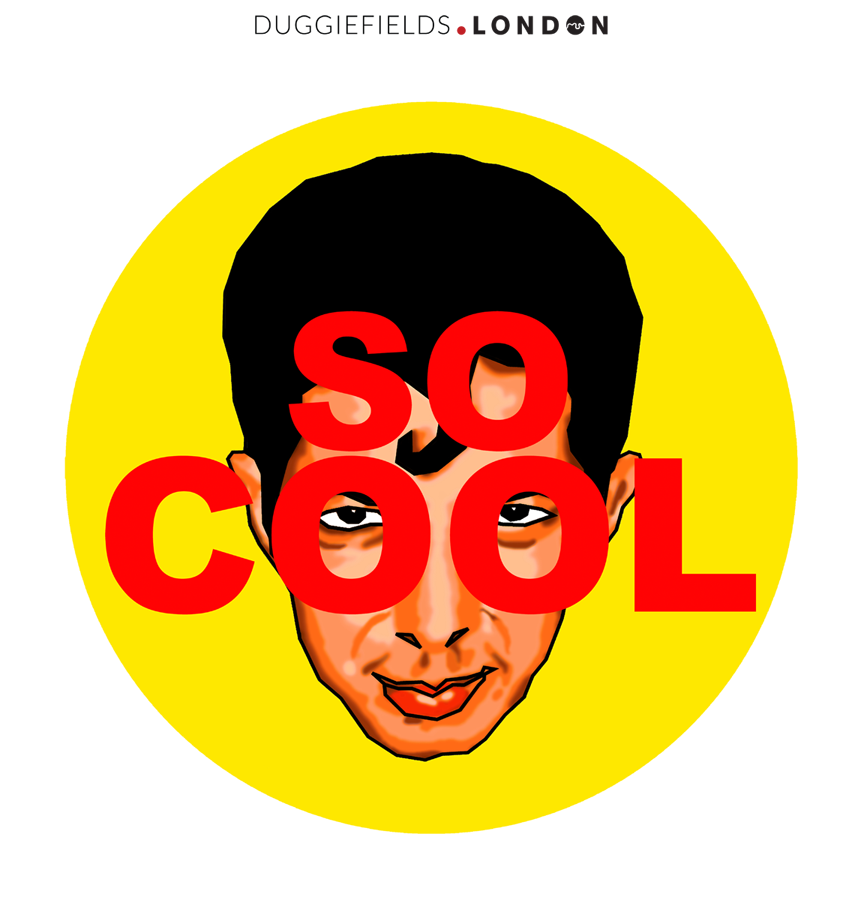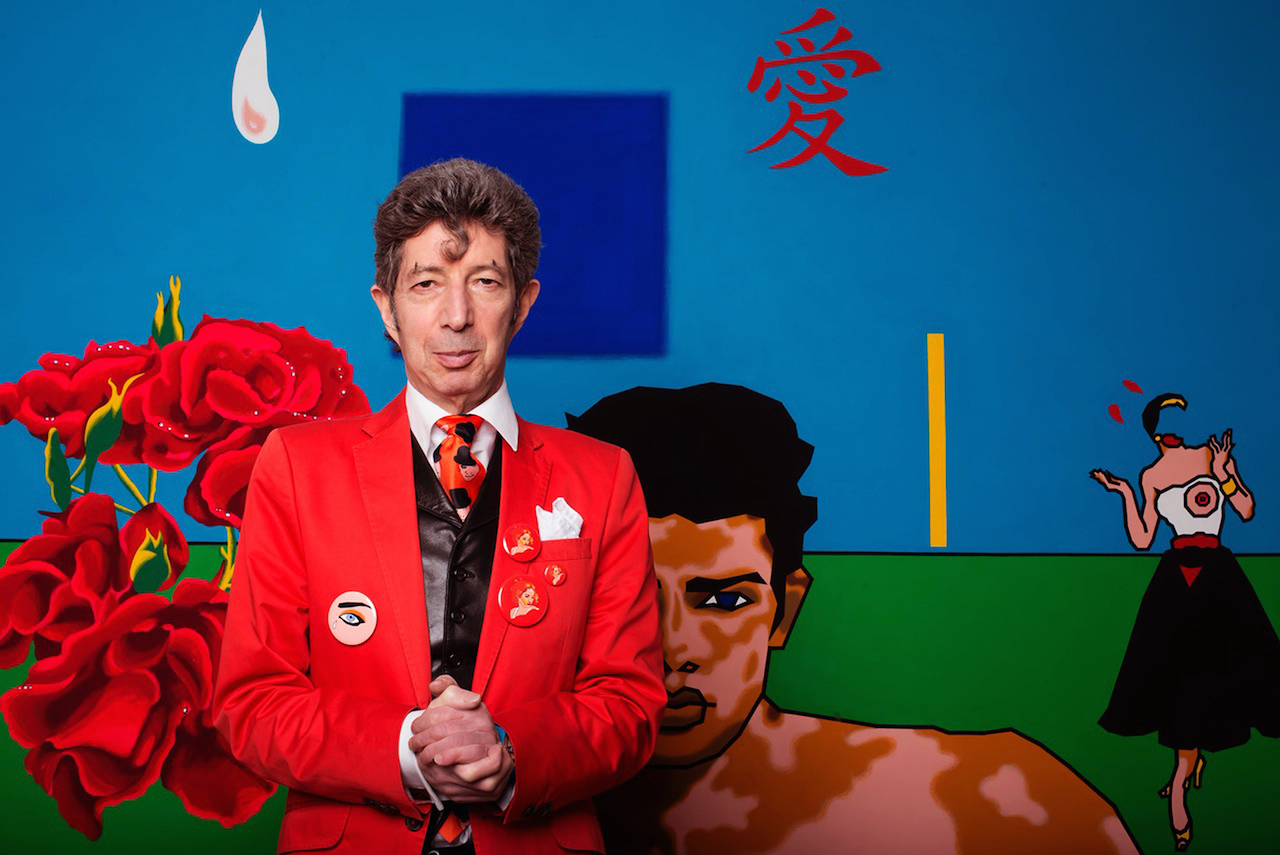It seems somehow fitting to go to the home of Duggie Fields to discuss the upcoming celebration of his film work at BFI Flare, and end up talking about almost everything but. Born on the day the A-bomb fell on Hiroshima and coming of age during a Swinging London that he was very much part of (his flatmate was a young Syd Barrett, no less), the work of the acclaimed post-Pop artist is marked by the great upheaval and change of what he describes as the “post-war baby bulge”: that incendiary group of teenagers who moved to London from the suburbs, studied at places like the Chelsea School of Art, and became the first generation to truly rip it up and start again. At 70, the sometime Comme des Garçons muse is still changing – learning to draw on the computer, sampling music on Logic Pro – albeit all from the very same, unmoving flat: a Day-Glo treasure trove of artwork and kitsch, in his beloved but disappearing Earls Court.
When were you first approached by BFI Flare?
I think last year sometime. I’ve been making little films, which I’ve never seen on a big screen and I thought – that would be lovely, yes.
Do you enjoy that looking back over of things?
I haven’t seen them! Well, I haven’t seen them in the cinema. But, I prefer doing new work than looking at old things… And I haven’t seen my new stuff on screen so that’s more what I’m interested in doing it for. I’m interested in how that feels.
What are you working on right now?
Okay, I’ve got an idea for a painting I’m working on that… Maybe it’s at the halfway stage. I always work them out, very precisely, before I start on canvas, because of the way I paint. So I do lots and lots of studies on computer first. I’ve got a painting on the way. I’ve got a piece of music on the way, which is going into an animation. And the animation is on it’s way. None know quite where they’re going to end up but they’re all getting somewhere.
Is that always the case with your work?
Yeah. I don’t know what the finished product’s going to be ever. I start doing words, and I don’t know if I’m going to use the words or if that’s to get me going. And the same with the music. And the same with the drawing as well actually. I just start and the process takes over.
And there’s never an aim?
The aim is only to carry myself along with it to finish it. Then to look at it when it’s finished and find I’m interested in it enough to make me want to do something else. So it’s a process. And being able to continue the process… I can’t articulate what I’m trying to do, because if I could I’d just be doing the articulation, I wouldn’t be bothered with the doing, because the doing is hard work.
Is it the same with film?
I take photos or film, almost everyday. Then I use things that I find on the internet just by random, and they lead me to look at something else that’s interesting. Or I film things from scratch, specially. The thing I’m working on now is yet to have anything specially filmed, because that’s filming myself and I have to get into the right frame of mind to do it. Frequently I do it when I don’t know what I’m doing, but I’m in the mood to. And I think, whatever I do, I’ll make something work out of it. So far, I usually do.
It’s interesting that for work marked by such constant change, your actual physical location has remained fixed for so long…
I’ve been in this flat a long time, yeah. And I don’t know if that gives me a curious world view. I have a certain physical constancy, while everything is shifting around me.
When did you move in here?
Christmas 1968. And it was one of those chances where I’d gone to look at another flat and missed it by one person. I’d always said, I’ll never live in Earls Court but I’ve lived here ever since.
And it was here that you shared with Syd Barrett?
This was my room. That was his room and briefly we had a third person in the other room, then it was just me and Syd. Then it was me and Syd and one other person. Then it became me and Syd and maybe five other people and it got a bit crowded. And then he left and I had to get rid of the other people. And he never came back.
You’ve spoken a lot about how the area has changed, of course [Fields was a prominent voice in the campaign against the closure of Earls Court Exhibition Centre in 2014]…
The area is just vanishing before one’s eyes. That’s what I feels like at the moment. I’ve always had various buildings in the area round here – cafes, restaurants – where I’d go and eat and hang out. But now, I just walk past places thinking, I don’t want to go in there, I don’t want to go in there. The food is not worth it, the price is not worth it, there’s no atmosphere.
You’re not from London, are you?
No, I’m from the country. And I definitely don’t want to go back to the country. I’m a city person. I complain about the change but I think I’ve been spoiled… It’s been good fortune that it’s been space to work in. And even after all these years I can see bits of the architecture that I haven’t noticed. Then there are magnificent trees of course, magnificent plants. I was just admiring some dying camellias up the road. Red blossoms, sort of mouldering on the ground. It was very romantic.

I’d like to speak to you a little more about your approach to making music…
At the moment I’m using samples. And I’ve been taking them without listening to them and putting them in the track and cutting loops out of them and placing patterns out of them before I listen to them. And I’ve got some good results! Some really unexpected results. I’m not good at planning a structure beforehand, but I’m quite good at listening and zoning down to something I like…
Does that carry through into your life generally?
In my life, I’d say my work is very curious these days because it used to be… Um… I talk to other friends about how we used to do more, and life goes faster. I also live in a neighbourhood where I don’t have a contact with the neighbourhood in terms of people as well as place. I used to have friends who live nearby. And I have very few friends who live nearby now… Maybe that’s just age. I lost 13 people from my life in this last year. My neighbour died. We’d been neighbours the whole time I’ve lived here so 48 years. I feel the void beneath my feet. And that’s as well as the big building that brought hundreds of thousands of people to the area… I went to so many exhibitions and concerts. So many hundreds of thousands of people that come to the area. They’d come to the comic convention, Comic-Con, it used to be an annual event in Earls Court. And every year you would see these extraordinary creatures in the street. That character has suddenly vanished.
Have you always been drawn to people that express themselves though what they wear?
Yes. I have all sorts of theories about that. One is I’m a child of the 60s. I came to London in ’63 and met a whole lot of other people my age who were coming to London. The post war baby bulge, everyone came to the art schools in London essentially. And it was just as the King’s Road was taking off. So I met a whole other lot of people who were the same age, all starting off as art students, designers, architects, and a lot of them went on to be very influential. My flatmate’s band for instance…
I love how you call them “my flatmate’s band”.
Well did you have a college period when your flatmates had a band?
Yes, but the band wasn’t Pink Floyd!
That was the reality of it! I thought they were interesting but I didn’t know that the whole world would think they were interesting.
What was the scene like at that time?
There was this whole fashion change between the generations. Men with long hair were shocking to the older generations, let alone men experimenting with make up and women’s clothing. And it wasn’t cross gender, it wasn’t about anything. It just was and there was a visual community that you would see people on the Kings Road… I ended up living off there and going to college with these visions walking along the street. And I guess I wanted to be a vision too.

What do you do when you’re not working?
I like to watch a lot of things on television. I look at a lot of things on the internet. I’m online looking at things and listening to things, rediscovering and discovering new things… Real Housewives of Beverly Hills, I’ve been watching Real Housewives of Beverly Hills. I do like reality TV in general.
What is it you like about it?
Well it’s all Andy Warhol. It’s more interesting than what he’d use to do, where he’d just stick anyone in front of a camera but it is an extension of that… Fame is a curious thing. My real closeness with fame has been pop fame and not mine, but my flatmate’s. And my good friend Marc Bolan. Marc’s sense of fame, I think, ultimately, wasn’t necessarily his downfall, because his downfall was an accident, but it did derail him and he was just… Putting himself back again when he died, which is sad. But it did send him off the rails and it certainly sent Syd off the rails. Can it happen to artists? It does a little to artists. But art, by it’s nature, doesn’t really require the audience so much. It’s when you’re actually a performer.
But you must enjoy the attention your clothing brings?
But this is not for anyone else. This is for me. Okay, would I have put this on [today, a grey suit jacket, white polo neck, black skinny jeans and white trainers], if I was staying indoors. Not quite. This is going shopping, this is going out the house. But this I do [the hair] and this [the brows] I do even if I’m not going out the house. I’d have to be really feeling sick not to do it. Or on a beach.
When was the first time?
I don’t know. I think around 1975. I can find pictures of me from 1975 where it’s not there too, but there are definitely pictures of me where it is there in 1975. So it became permanent around then. Whether I’ll ever stop doing it I don’t know. I have thought, maybe I’ll stop doing it now. Maybe I’ll change. I like the idea of being able to change my mind.
Duggie Fields and Film takes place tomorrow (26 March) at BFI Flare.

Credits
Photography Michiko Nakao
